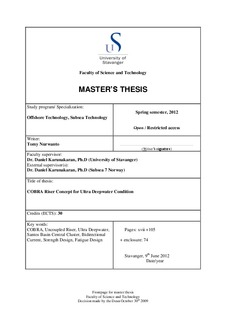| dc.description.abstract | Offshore ultra deepwater field is being promising as the future of oil and gas reserves. The advancement of technology in ultra deepwater has been leading Brazil into one of the promising offshore market. A Brazilian state-owned oil operator, Petrobras, confirms that 33% from their total exploration area are located at water depth below 1500 m (Salies, 2005). It can be seen that the future of oil and gas exploration and production lies in ultra deepwater.
The development of ultra deepwater field posed many challenges, in particular, on the selection of the riser concept. For ultra deepwater environment, the long suspended length of riser will significantly increase the vessel payload. High external hydrostatic pressure on the riser will increase the probability of collapse failure. Large dynamic motions of the vessel due to waves, and also large vessel offsets from wind, current and slow-drift motion yields potential buckling issues at the touch-down-point (TDP). In addition, potential fatigue problems due to vessel motions and soil-riser interactions also present at touch-down-point (TDP) area. Large current speed in deepwater field might also lead to vortex induced vibration (VIV) which eventually will contribute to significant fatigue damage for particular riser sections. By looking into these challenges, it is very important to select the most appropriate riser concept for the ultra deepwater field.
Catenary Offset Buoyant Riser Assembly (COBRA) as newly developed hybrid riser concept offers a solution to overcome the challenges in ultra deepwater field. In general, COBRA riser arrangement consists of a catenary riser section with a long-slender sub-surface buoyancy module on top which is tethered down to sea bed via two mooring lines. The catenary section from top of the sub-surface buoy is connected to the floater by a flexible jumper. This flexible jumper can effectively absorb the floater motions, which give significant improvements for both strength and fatigue performance on the overall system. As a hybrid riser concept, this concept offers cost effective solution by avoiding all the expensive bottom assemblies that normally needed for a hybrid riser concept.
This thesis focuses on COBRA riser concept for offshore Brazil ultra deepwater environment, specifically for Santos Basin Central Cluster region at 2200 m water depth. It is observed that there is common sudden change phenomenon on the current direction in Santos Basin area. In this thesis, the effect of bidirectional (2-directions) current is analyzed, and the comparison with unidirectional current is discussed thoroughly. The analyses are focused on the global strength design performance under extreme environmental load and global fatigue design performance of the riser due to wave induced and VIV induced.
This thesis captures detail analysis of COBRA base case configuration. In addition, further sensitivity studies from the base case riser arrangement are also presented. The parameter on sensitivity studies are determined based on possible alternative riser arrangements, i.e. locating the sub-surface buoyancy in deeper area, connecting the flexible jumper through the bottom section of the sub-surface buoyancy, and also alternative buoyancy tethers configurations on the seabed.
Based on detailed strength and fatigue analyses result, this thesis concludes that COBRA riser concept has a robust design and it is feasible for 2200 m water depth, in particular for Santos Basin Cluster Region area. It is also shows COBRA riser concept has sufficient strength performance even for extreme bidirectional (2-directions) current. | no_NO |
